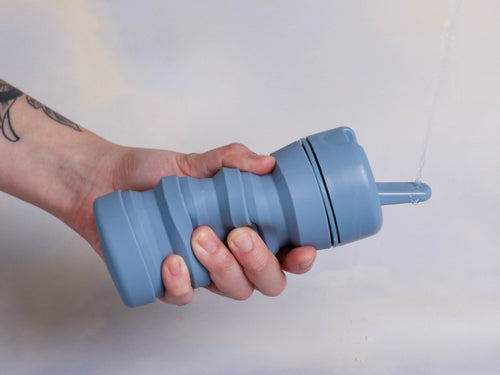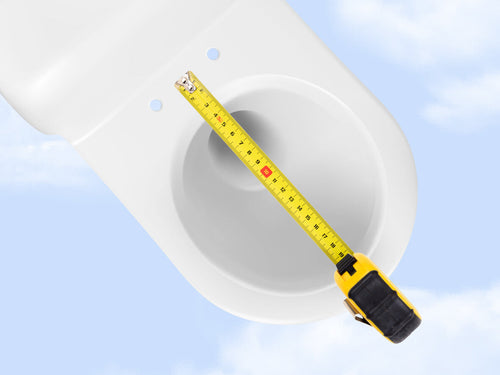
If you are already environmentally conscious and friendly throughout your daily routine, TUSHY thanks you. However, there’s one daily habit that has a large impact on the environment and climate change, which you might not be aware of. That daily habit is the toilet paper you use to wipe after pooping or peeing.
Yes, those sheets of TP you purchase online or at your local grocery store add up and support a not so environmentally-friendly industry. The cost and environmental impact were heavily felt in early March of 2020 during the infamous toilet paper shortage a.k.a. Poo-pocalypse. Due to the toilet paper hoarding of some individuals, supply lines were constipated.
Certain tissue product brands are worse than others, but generally, conventional toilet paper has environmental drawbacks. Continue reading to find out the environmental issues bathroom tissues cause and simple alternatives and ways you can help. For a quick guide, see our infographic here.
Who is Wastefully Wiping
The United States and its citizens are known globally for being a nation of consumers. Well, when it comes to toilet paper, Americans are the number one consumers worldwide. According to Statista, the average American can be expected to go through 141 rolls of toilet paper per year, or 12.7 kilograms (28 pounds) per year. Germany and the U.K. follow up by averaging 134 and 127 rolls per year. According to data from several major toilet paper manufacturers, it’s estimated that people used approximately 40% more toilet paper than normal if they spent the majority of their time at home.
Despite making up only 4% of the world’s population, Americans account for close to 20% of the world’s toilet paper consumption. For toilet paper manufacturers, business is far from plopping. In fact, the worldwide toilet paper industry is worth $64 billion, while the U.S. owns approximately $31 billion shares of that total.

Where Does Toilet Paper Come From?
Not only is the amount of toilet paper consumption by first-world countries a problem, but so are the harvesting and manufacturing process. The following sections will delve into the process of making toilet paper and how each step harms the environment.
Traditional Toilet Paper Relies Heavily on Virgin Fiber Pulp
Depending on the brand and company, the ingredients for tissue products vary. Tissue products such as paper towels, facial tissues, and toilet paper, have one ingredient in common: paper pulp. Paper pulp derives from a variety of sources such as virgin fiber (wood that has never been used in other products), post consumer recycled content, pre-consumed recycled content, and other fibers such as bamboo or wheat straw.
Virgin fiber, also referred to as virgin fiber pulp, is by far the most problematic of paper sources. Virgin fiber pulp comes from both softwood and hardwood trees. Hardwood trees are typically deciduous (shed their leaves annually) while softwood trees are spruce trees and other coniferous trees (bearing cones and evergreen leaves). These coniferous trees can often be found in Canada’s boreal forest and in the northwest and southeastern regions of the United States.
Tissue Paper Companies Are Deforesting Millions of Acres
To extract the virgin fiber pulp, logging companies often decimate boreal forests. According to Stand.earth and the National Resources Defense Council (NRDC) report, “The Issues with Tissue: How Americans are Flushing Forests Down the Toilet,'' between 1996 and 2015 more than 28 million acres of the boreal forest were logged, which is nearly equivalent to the state of Ohio. Even worse, 90% of this logging was done by clearcutting, a process that removes nearly all trees from an area. These clear-cut areas can take more than a century to return to pre-logging conditions.
Like many living forests, the Candian boreal forest removes carbon dioxide from the atmosphere, which assists in offsetting greenhouse gas emissions from other sources. According to another NRDC report, “the entire Canadian boreal region, including peatlands, removes carbon dioxide equivalent to the annual emissions of 24 million passenger vehicles.”
By clearcutting these areas, not only is the tissue paper industry harming the environment, but they are also reducing many animal’s natural habitats. For instance, in 2016, approximately half of the boreal woodland caribou’s original North American habitat remains. Other species such as marten, lynx, and moose, which inhabit and rely on the Canadian boreal forest, are also being effected.
Tissue paper companies also heavily impact other regions in North America. The southeastern United States has and continues to be, overly decimated. The region from Appalachia to the Florida Panhandle supplies approximately 27% of the world’s paper products. Even more frightening, the harvesting in this region occurs at four times the rate of South American rainforests.
Pulp Mills Are High-Polluting

After hardwood and softwood trees are clearcut for their virgin fiber, they are then logged to pulp processing mills. According to Industrial Shredders, at these mills, trees are unbarked and then go through a chipping process. The wood chips are then mixed with other chemicals in massive pressure cookers for approximately three hours to produce pulp.
To strengthen and whiten the tissue paper, the pulp is then washed and cleaned with elemental chlorine free (ECF) bleach. Until the mid-1990s, tissue paper companies used elemental chlorine bleach, which released dioxins and other toxic chemicals into the water and air. Despite its name, ECF bleach still releases chlorine gas as a by-product into the atmosphere and water.
The bleached pulp then gets mixed with water to produce paper stock. This mixing process has a 99.5% water to 0.5% fiber distribution. And according to Treehugger, making a single roll of toilet paper uses 1.5 pounds of wood and 37 gallons of water.
The entire tissue paper process, from harvesting virgin fiber wood to using ECF bleach and large amounts of water, harms the environment. However, there are eco-friendly options you can use.
Eco-Friendly Alternatives
All right, feel guilty yet from all the toilet paper you have used and flushed down the toilet? That’s okay, just try to begin using some of these eco-friendly toilet paper alternatives below.
Bidets

The most environmentally friendly alternative to traditional toilet paper is bidets. A bidet uses about an eighth of a gallon of water per use. This volume of water is far less than what it takes to produce a single roll of toilet paper, which is 37 gallons of water. If you use a bidet instead of toilet paper, you will save around 384 trees, which is the number of trees cut down to supply one person’s lifetime toilet paper supply.
Beyond helping the environment, you will also be saving a different kind of paper, money. Our classic affordable bidet costs $99.00. In comparison, the average American spends around $120 per year on toilet paper. Over five years, you’ll save close to $500 by simply using a bidet. If you are currently using a bidet or are contemplating purchasing one, also consider using bum towels or TUSHY tissues so you can do your business guilt-free. Well, except for when you stink up the bathroom.
Bamboo
Bamboo toilet paper is another great alternative to virgin fiber toilet paper. Bamboo is a highly versatile plant that can grow in an array of climates and does not need as much space as boreal forests. Bamboo can grow 20 times faster than trees found in the boreal forest. Another benefit of bamboo toilet paper is that it takes 0.59 gallons of water to produce during the manufacturing stage. That reduction equates to 30% less water per roll than toilet paper sourced from softwood and hardwood trees.
Although bamboo TP is a great alternative to traditional TP, some bamboo plantations are located in recently deforested areas. Therefore, producers and consumers should check to see if the Forest Stewardship Council (FSC) certified that the bamboo was sustainability sourced. Please note that TUSHY’s bamboo toilet paper is in the process of being FSC certified. You can see how TUSHY’s toilet paper is made here.
Recycled Content
One way to help the environment is purchasing toilet paper constructed from recycled materials, which generates 60% less sulfur dioxide than toilet paper produced from virgin fiber pulp. Recycled content can be broken into two categories, postconsumer and pre-consumer products.
Postconsumer content is reused after its initial purpose. It is recycled content and is not harvested from forests. Pre-consumer recycled content or “manufacturing waste” is recovered from scraps or trimmings from in-house manufacturing operations such as printer overruns or unused stocks. The U.S. Environmental Protection Agency (EPA) recommends that consumers purchase toilet paper that contains 20–60% postconsumer recycled content and 20–100% total recovered fiber.
Wheat Straw
Wheat straw, also known as “agricultural residues,” is the substance left behind after deforestation or harvesting. Traditionally, wheat straw has been treated as waste and oftentimes will be burned, contributing more air pollution. The production of wheat straw in the tissue industry is still in the adolescent stages of development, but some of the biggest paper-based consumer goods brands are already investing in the technology for wheat straw toilet paper.
There you have it. You now know that after doing your business you have environmental and budget-friendly options to traditional toilet paper products. So, for the health of the environment and your own peace of mind, consider some of the alternatives mentioned above. If you’re looking to be a total friend to the environment, consider our eco bundle or when you’re on the go, check out our travel bidet.
For more information on why traditional toilet paper is harmful to the environment and ways you can help, watch the video below and review the infographic.




























